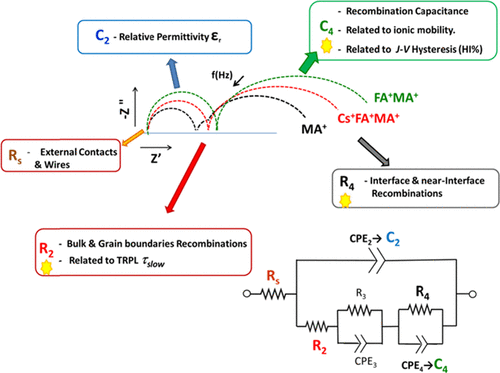当前位置:
X-MOL 学术
›
ACS Appl. Energy Mater.
›
论文详情
Our official English website, www.x-mol.net, welcomes your
feedback! (Note: you will need to create a separate account there.)
Using Monovalent- to Trivalent-Cation Hybrid Perovskites for Producing High-Efficiency Solar Cells: Electrical Response, Impedance, and Stability
ACS Applied Energy Materials ( IF 5.4 ) Pub Date : 2020-10-16 , DOI: 10.1021/acsaem.0c00884
Daming Zheng 1 , Tao Zhu 1 , Thierry Pauporté 1
ACS Applied Energy Materials ( IF 5.4 ) Pub Date : 2020-10-16 , DOI: 10.1021/acsaem.0c00884
Daming Zheng 1 , Tao Zhu 1 , Thierry Pauporté 1
Affiliation

|
Production of high-efficiency solar cells based on organometal halide perovskites has emerged recently as the most promising technology. During the past years, innovative film processings have been developed for increasing the device’s performance and stability. The two most efficient strategies are (i) to complexify the perovskite composition by mixing monovalent cations and (ii) to add additives in the precursor solution, which are eliminated upon the film annealing and postdeposition processing steps. In the present work, perovskite films varying in their monovalent cation content, from one to three (MAPbI3, Cs0.08FA0.80MA0.12Pb(I0.88Br0.12)3, and FA1–xMAxPbI3), and being optimized to reach a high efficiency up to 22.2% have been thoroughly compared for their steady-state and impedance electrical responses. Much information has been extracted from the electrical impedance spectroscopy data after fitting using equivalent electrical circuits. With the help of complementary measurements (photoluminescence, scanning electron microscopy, Voc measurements, etc.), the spectral features have been assigned to physical phenomena. The relative permittivities of MAPbI3, Cs0.08FA0.80MA0.12Pb(I0.88Br0.12)3, and FA1−xMAxPbI have been extracted from the high-frequency capacitance C2. The high-frequency resistance R2 has been related to the slow lifetime of the time-resolved photoluminescence and assigned to the bulk recombination resistance of the perovskite. The low-frequency resistance R4 has been assigned to the recombinations occurring at and near the interfaces. The low-frequency capacitance C4 has been related to the J–V curve hysteresis and assigned to the recombinations. The recombination in perovskite solar cells is phase delayed due to the dynamics of ions and related defect formation. It induces an imaginary component in the impedance spectra that is analyzed as C4. Overall, the strategy of mediating the growth of FA1–xMAxPbI3 perovskite double cations by additives is found to be the best one to suppress recombinations, suppress ion mobility, reach high efficiency with low hysteresis, and stabilize the perovskite compound.
中文翻译:

使用单价至三价阳离子混合钙钛矿生产高效太阳能电池:电响应,阻抗和稳定性
最近,基于有机金属卤化物钙钛矿的高效太阳能电池的生产已成为最有前途的技术。在过去的几年中,已经开发了创新的薄膜处理技术来提高设备的性能和稳定性。两种最有效的策略是(i)通过混合单价阳离子来复合钙钛矿组合物,以及(ii)在前体溶液中添加添加剂,这些添加剂在薄膜退火和后沉积处理步骤中就消除了。在本工作中,钙钛矿薄膜的单价阳离子含量从一到三个变化(MAPbI 3,Cs 0.08 FA 0.80 MA 0.12 Pb(I 0.88 Br 0.12)3和FA1– x MA x PbI 3),并经过优化以达到高达22.2%的高效率,已对其稳态和阻抗电响应进行了全面比较。在使用等效电路拟合后,已从电阻抗光谱数据中提取了很多信息。借助辅助测量(光致发光,扫描电子显微镜,V oc测量等),光谱特征已分配给物理现象。MAPbI 3,Cs 0.08 FA 0.80 MA 0.12 Pb(I 0.88 Br 0.12)3的相对介电常数从高频电容C 2提取FA1-xMAxPbI 。高频电阻R 2与时间分辨的光致发光的缓慢寿命有关,并且与钙钛矿的整体复合电阻有关。低频电阻R 4已分配给在界面处和界面附近发生的重组。低频电容C 4与J–V曲线的迟滞有关,并分配给了重组。由于离子的动力学和相关缺陷的形成,钙钛矿太阳能电池中的重组发生了相位延迟。它在阻抗谱中感应出一个虚部,将其分析为C 4。。总体而言,发现通过添加剂介导FA 1– x MA x PbI 3钙钛矿双阳离子生长的策略是抑制重组,抑制离子迁移,在低磁滞下达到高效率并稳定钙钛矿化合物的最佳方法。
更新日期:2020-11-23
中文翻译:

使用单价至三价阳离子混合钙钛矿生产高效太阳能电池:电响应,阻抗和稳定性
最近,基于有机金属卤化物钙钛矿的高效太阳能电池的生产已成为最有前途的技术。在过去的几年中,已经开发了创新的薄膜处理技术来提高设备的性能和稳定性。两种最有效的策略是(i)通过混合单价阳离子来复合钙钛矿组合物,以及(ii)在前体溶液中添加添加剂,这些添加剂在薄膜退火和后沉积处理步骤中就消除了。在本工作中,钙钛矿薄膜的单价阳离子含量从一到三个变化(MAPbI 3,Cs 0.08 FA 0.80 MA 0.12 Pb(I 0.88 Br 0.12)3和FA1– x MA x PbI 3),并经过优化以达到高达22.2%的高效率,已对其稳态和阻抗电响应进行了全面比较。在使用等效电路拟合后,已从电阻抗光谱数据中提取了很多信息。借助辅助测量(光致发光,扫描电子显微镜,V oc测量等),光谱特征已分配给物理现象。MAPbI 3,Cs 0.08 FA 0.80 MA 0.12 Pb(I 0.88 Br 0.12)3的相对介电常数从高频电容C 2提取FA1-xMAxPbI 。高频电阻R 2与时间分辨的光致发光的缓慢寿命有关,并且与钙钛矿的整体复合电阻有关。低频电阻R 4已分配给在界面处和界面附近发生的重组。低频电容C 4与J–V曲线的迟滞有关,并分配给了重组。由于离子的动力学和相关缺陷的形成,钙钛矿太阳能电池中的重组发生了相位延迟。它在阻抗谱中感应出一个虚部,将其分析为C 4。。总体而言,发现通过添加剂介导FA 1– x MA x PbI 3钙钛矿双阳离子生长的策略是抑制重组,抑制离子迁移,在低磁滞下达到高效率并稳定钙钛矿化合物的最佳方法。































 京公网安备 11010802027423号
京公网安备 11010802027423号